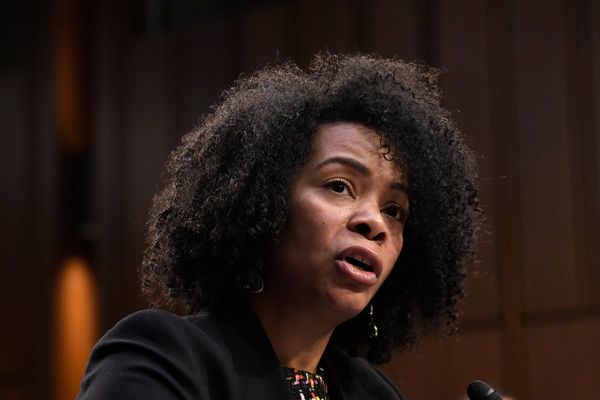
Do you know what yrabbī ḥamām means? It is one of 330 slang terms that Lebanese artist Marwan Kaabour has put in his debut book, The Queer Arab Glossary. Yrabbī ḥamām is a colloquial term that means “pigeon keeper”, with the word ḥamām (pigeon) a common euphemism for penis. It’s Kaabour’s favourite entry and, he says, ḥamām is used “in an endearing way, like in a way a mum and child would joke about”. The term can also refer to someone who engages in gay sex, and it is accompanied by an illustration by Palestinian graphic designer Haitham Haddad, showing a cheerful gay man with a moustache feeding pigeons depicted as flying penises.
The book provides a snapshot of the linguistic landscape of queerness in Arabic-speaking regions, with examples from Levantine, Iraqi, Gulf, Egyptian, Sudanese and Maghrebi dialects. “I am waging a battle on two fronts with this book,” says Kaabour, who is based in London. “The first is directed towards the authorities of my own people, those who claim that queerness is a western import. I am debunking that. I’m showing them how we have been a big part of Arab society since day one. The second is facing westwards, particularly to those who have rightwing politics, who say that Arabs are somehow innately homophobic or sexist.”
Kaabour faced many difficulties, not least the fact that “accessible resources about queerness are very rare” in the Arab world, except in the footnotes of academic dissertations or through pejorative mentions in “gossip magazines”.
Haddad illustrates 30 terms, bringing a delightful touch of humour to the book. Take shawwāya, which is used in Morocco and Tunisia. Coming from the root shawi (to grill), it means “grill rack” and refers to versatile gay men who flip during sex, assuming both top and bottom roles – “like meat on a grill”, the book says. The illustration shows two men in a 69 position on a grill rack engulfed in flames.
Derogatory and humorous terms are not the only ones included in the glossary. There are also sweet, serious and tongue-in-cheek expressions. From Lebanon, Kaabour’s home country, comes the word agraba, which means “scorpion” and refers to a cisgender or trans woman who tries to “steal” a gay man’s partner. A significant number of homophobic slurs utilise the word for “worms”, such as the Iraqi term dūdakī, meaning “riddled with worms”. Kaabour sums up Haddad’s illustration for this term as “a confident, sassy, Medusa-like mythological character with worms rather than snakes as hair”.
In his introduction, Kaabour writes: “When the language we inherit does not equip us with the tools to speak about ourselves, we create our own.” Eight essays by leading queer Arab writers and artists also feature, including one by Rana Issa, from Lebanon, which envisages a morning gossip session between real and fictional characters. These include Iraqi singer Masoud El Amaratly, one of the Arab world’s most famous transgender icons, sitting at a table with, among others, Bassem Feghali, a Lebanese drag queen.
The Queer Arab Glossary was born out of Takweer, an online platform Kaabour launched in 2019 to excavate queerness in Arab history and popular culture. He had felt irritated a year earlier, while watching a drag show in Beirut in which performers based their show heavily on RuPaul’s Drag Race and other western landmarks. “I am just resistant,” he says, “to the idea of Eurocentric queerness being parachuted in.”
The book is the result of a four-year-long project that began during peak lockdown. Kaabour asked Takweer’s followers to suggest queer words specific to their dialect, and began collating “raw data” in an ever-growing spreadsheet after he was inundated with responses. He is a graphic designer and “makes books for a living”, which feeds his fascination with text and typography. The Queer Arab Glossary is both written and designed by him.
He joined the design agency Barnbrook after graduating in graphic design from the London College of Communication, having moved to London in 2011. During his time at Branbrook, he worked as lead designer on The Rihanna Book, a visual autobiography of the singer that Time Magazine named one of the best photo books of 2019.
Kaabour was born in Beirut in 1987; his father was a musician and his mother a painter. One of his earliest memories from his “overactive, theatrical” childhood is being labelled by a close relative as fūfū. He explains: “Fūfū is just like sissy. My parents would make comments, but they were very careful not to damage my sense of self. But when I became old enough to venture into the world on my own, I would hear in the street or in school, ‘Fūfū!’”
He adds: “I was well into my 20s when I came to terms with it. It all has to do with someone telling you there’s something at the core of your identity that is broken – only to realise one day that there was nothing broken in the first place.”
The Queer Arab Glossary highlights an imbalance between the number of slang words relating to queer men and queer women, and Kaabour says that the gender inequality of society at large also exists in the queer Arab community. “The majority of the words in the glossary that pertain to women,” he says, “all have to do with taking them back to the man.” Kaabour cites the Levantine term for a queer woman, mistarjila, which means “like a man”. He adds: “So even the slur is misogynistic.”
Kaabour wants his book to reflect “the outstanding creativity, wit, humour and sass” he found out there. During our interview, in the Hackney flat he shares with two other people and two sphynx cats, he wears a white T-shirt with the single word “Palestine” written on it, next to a small image of an olive tree. “Unless,” he says, “I anchor my queer identity in my own culture, in my own people, in the experiences that make my identity unique, I’ll always feel like I don’t belong. I try to give the queer Arab community an anchorage in their own self and say, ‘Here are our idols, here are our stories, here are our tragedies, and here are our celebrations.’”
The Queer Arab Glossary edited by Marwan Kaabour (Saqi Books, £15.99). To support the Guardian and Observer, order your copy at guardianbookshop.com. Delivery charges may apply.







